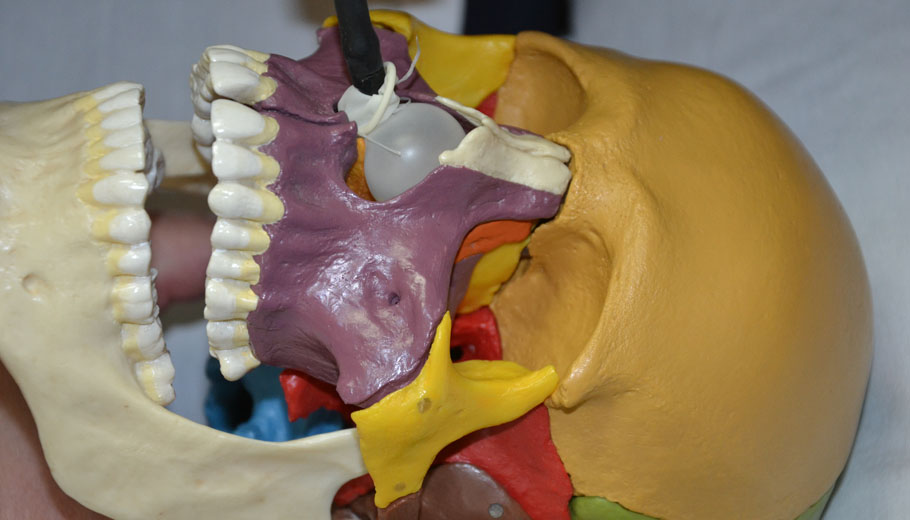
Treatment puts balloon into nose
By James Card
Freshman Max Dolski spent part of his basketball season out with a concussion when a rebounding opponent planted an elbow into his skull.
He sat on the sidelines per school protocol but after undergoing a nasal release technique at Spine and Sport Physical Therapy of Waupaca he was back on the court.
The technique reset his pain threshold. The concussion left him with low-grade headaches that eventually became the new normal for him.
Dolski realized after the treatment what he thought previously was zero level of pain was actually a three (on a 0-10 scale).
His symptoms cleared and he recently set a personal record of scoring the most points he ever had in a game.
Physical therapist Mike Koch treated him with a technique that involves inserting a latex finger-sized balloon (called a “cot”) into a nasal passage, pumping it up with a blood pressure inflation bulb.
The patient takes a deep breath and the opposite nostril is compressed to prevent air from escaping. The cot expands into the nasopharynx causing it to widen and the balloon pushes against the bones of the sphenoid, a compound bone that forms the base of the cranium.
Pressure is felt in the nose and head and some patients report hearing clicks in their skull, like knuckle cracking sounds or their ears pop. It isn’t painful but it is strange.
When the cot was removed, Dolski said it was like he was coming up for air from underwater. He also reported feeling very light on his feet, like he was walking on the moon and all of the tension was gone.
Beyond concussions
Koch is one of two practitioners certified to do the technique in Wisconsin. He was trained by Cynthia Stein, the founder of Conquer Concussion, a training center for alternative concussion treatments.
Koch also includes cranial sacral therapy to the treatment that relieves compression in the head, neck, and back.
Koch learned the nasal release technique at the request of his patient Glen Hollatz. He got in touch with Stein at Conquer Concussion and performed the technique on himself.
“I’ve had a headache for 10 years. It’s a unilateral pressure headache. I figured we’ll give this a try. I would say within the first treatment or two, I was 20 to 40 percent improved. It hasn’t gone but I haven’t had anything that touched my headache before – whatever pill or whatever thing – but we do this and wham! Now we’re doing things,” said Hollatz.
Hollatz visited the Mayo Clinic and other hospitals but could not find the relief. His initial nasal release treatments with Koch were in January 2022.
He also said it helped his vision. Hollatz had an eye appointment with a neuro-optometrist a month before his first nasal release treatment and was prescribed low-prism glasses.
In April 2022, he met neuro-optometrist again and he tested better without the glasses.
Hollatz also had braces as a kid.
“This actually straightened my top palette. I had a gap in my front teeth and that closed up. You can definitely feel it,” he said.
He does the treatment every other week for his chronic headache but for treating concussions only a few visits may be needed.
So far Koch has treated four student-athletes for concussions but also adults who say they never had a head injury but yet have some undiagnosed problem.
“Oh, yeah I fell of the swing when I was 5 or my brother hit me with a skateboard. There are all kinds of stories,” said Koch.
The treatment helps with snoring, hearing, migraines, sleep apnea, vertigo and other conditions.
“I‘ve had a battered woman had been hit in the face multiple times. One thing she noticed is that she could think clearer. She didn’t have to think for words. She could focus and didn’t have the brain fog,” said Koch.
“Your skull expands and contracts roughly six times a minute. It’s a different rhythm than your heart beat or respiration or peristalsis. It’s its own rhythm that pumps the cerebral spinal fluid through your spinal cord. All these skull bones move. As a cranial sacral therapist, we’re trained to get these sutures to move and to get this bone to move and try to balance the skull that way. The nasal release allows me to mobilize the sphenoid. The idea is, the sphenoid interacts with 19 of the 22 skull bones. So if can get that sphenoid to move, I can unlock all these,” Koch said.
